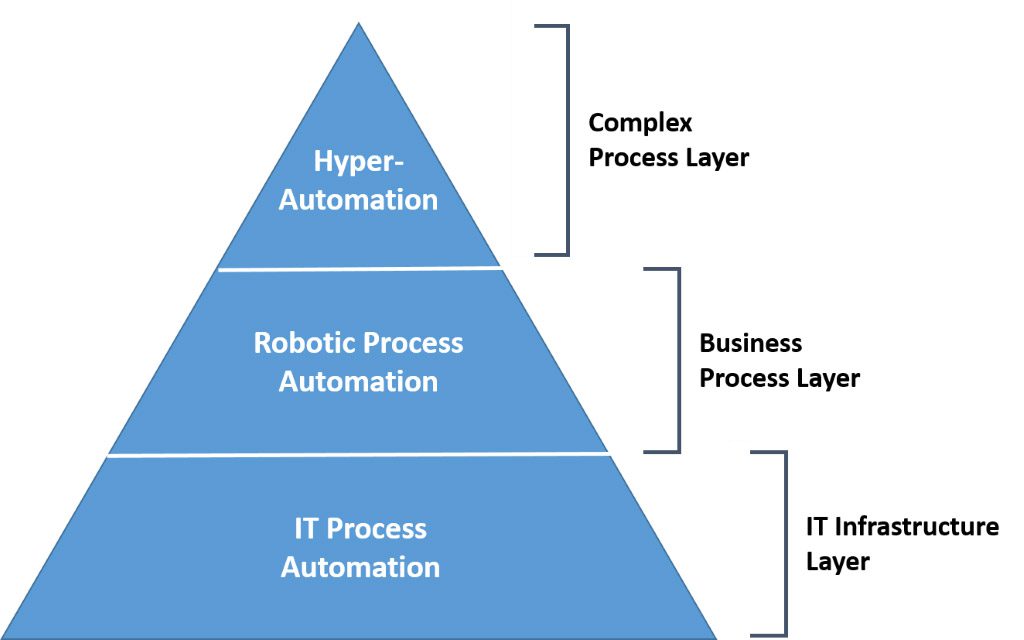The Evolution of Automation Technologies
Automation is making waves in many industries worldwide and encompasses a wide range of technologies including endpoint management, robotic process automation (RPA), artificial intelligence (AI) and machine learning (ML).
Automation allows organizations to get more things done at a lower cost. It increases the efficiency of individuals, teams and companies as a whole, and is likely to revolutionize the way organizations function.
Let’s take a look at a simple three-level hierarchy of automation technologies.

IT Process Automation
The foundational layer of all automation technologies is the automation of IT processes. This involves the automation of routine IT tasks and workflows such as server maintenance, software patch management and software updates. It also includes auto-remediation of IT incidents and associated service tickets.
IT processes are automated by running scripts or what we call Agent Procedures. With Kaseya VSA, our unified remote monitoring and management (URMM) software, you can customize pre-built automation scripts or create your own in the Agent Procedure Editor.
Auto-remediation of incidents involves first setting up monitoring on the endpoint and then automatically executing the script(s) when an alert occurs. This process can involve both the endpoint management tool and your service desk solution where you manage tickets. Tickets can automatically be created by the endpoint management tool. Then, those tickets can be resolved using automated workflows in the service desk to run the scripts.
Benefits of IT Process Automation
A few benefits of IT process automation are:
- Reduced human error: Automating IT processes ensures there is accuracy in every step and reduces the chances of errors occurring.
- Increased IT operational efficiency: IT process automation frees up IT technicians to work on more challenging tasks and strategic initiatives that will help grow the business.
- Higher system uptime: Auto-remediation of incidents means that problems are resolved faster and your systems and services have higher availability. This, in turn, keeps your business productivity high as well.
Challenges With IT Process Automation
The major challenge with automating IT processes is creating the scripts that automate the tasks. With the Kaseya Automation Exchange, you can get started quickly and easily. Kaseya Automation Exchange offers more than 800 pre-built automation scripts, monitor sets and reports that can be used to reduce the time it takes for you to implement automation.
Robotic Process Automation
Research firm Gartner predicted that the global robotic process automation (RPA) market revenue will reach $1.89 billion in 2021 — an increase of 19.5 percent from 2020.
RPA is the business process layer. In RPA, simple, repeatable rules are followed by “bots” or virtual systems to automate manual computing steps or simple business processes. For example, in the insurance industry, RPA allows companies to automate the processing of claims without manual intervention. In any organization, the process of onboarding/offboarding of employees can be done with RPA.
Another use case for RPA is in the hiring process. It enables human resource executives to automate some or all of the process. This means a job candidate can be hired or rejected automatically based on a certain set of rules.
Benefits of RPA
- Cost-effective: In a Deloitte survey, 59 percent of companies that implemented RPA for their business processes said that RPA reduced the cost of their operational activities.
- Improved productivity and quality of work: Faster service can be provided, errors can be minimized and consistent quality can be produced with RPA.
- Better decision making: With analysis of more accurate data, you can make better business decisions faster.
Challenges With RPA
- Scalability: If you do not pick the right processes to implement with RPA, scaling can become an issue. For a successful RPA journey, identify processes with clear processing instructions based on standardized rules. Consider repetitive processes that are susceptible to error and require a higher degree of manual input. RPA can be used to save time and improve productivity in these cases.
- Enabling end-to-end automation: RPA tools may be insufficient for very complex processes. In such cases, companies can either break down their processes into simpler tasks that can be automated with RPA or progress to hyperautomation.
Hyperautomation
Hyperautomation brings together artificial intelligence/machine learning (AI/ML) tools with RPA to enable the automation of complex business processes. Hyperautomation can lead to real digital transformation of the business. As one of the top 10 strategic trends of 2021 touted by Gartner, the idea of hyperautomation is to automate “anything” that can be automated.
Implementing hyperautomation requires streamlining entire processes in an organization, getting rid of legacy applications and enforcing lean, optimized and interconnected processes.
One of the hyperautomation use cases is automating all banking processes. Right from regulatory reporting, marketing, bank servicing, payment and lending operations to customer support, all functions can be automated for a swift banking experience.
Benefits of Hyperautomation
- End-to-end automation: Starting from process discovery to measuring return-on-investment (ROI), all of this can potentially be automated.
- Significant transformation: When every part of a complex process is automated, the operation of the business can be transformed.
Challenges With Hyperautomation
The major challenge with hyperautomation is actually automating complex processes. Grappling with process complexity can cause frustration and increase implementation costs.
Create a roadmap for the processes to be automated. Start with the smaller ones and expand to the most complicated ones.
Conclusion
For automation to be highly beneficial, companies must choose which activities to automate, the level of automation to be implemented and the technologies to adopt based on their business needs. Having a strong foundation in IT process automation is the best place to start.
Learn about the 7 Processes to Automate to Improve Productivity and Reduce IT Costs in our checklist.

The post The Evolution of Automation Technologies appeared first on Kaseya.
*** This is a Security Bloggers Network syndicated blog from Blog – Kaseya authored by John Emmitt. Read the original post at: https://www.kaseya.com/blog/2021/02/16/the-evolution-of-automation-technologies/





